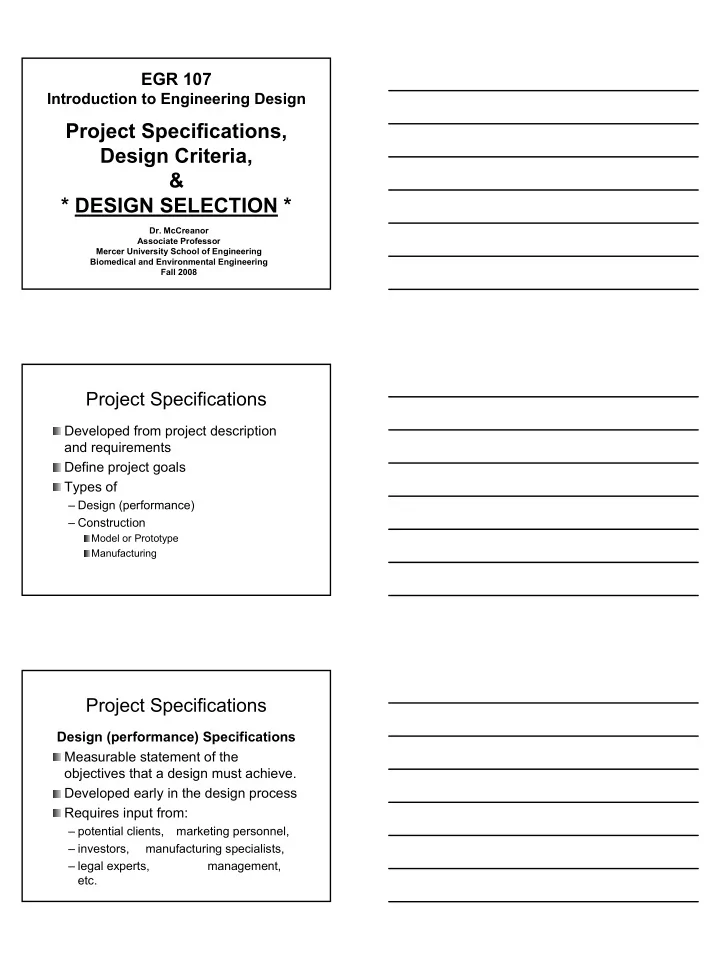

EGR 107 Introduction to Engineering Design Project Specifications, Design Criteria, & * DESIGN SELECTION * Dr. McCreanor Associate Professor Mercer University School of Engineering Biomedical and Environmental Engineering Fall 2008 Project Specifications Developed from project description and requirements Define project goals Types of – Design (performance) – Construction Model or Prototype Manufacturing Project Specifications Design (performance) Specifications Measurable statement of the objectives that a design must achieve. Developed early in the design process Requires input from: – potential clients, marketing personnel, – investors, manufacturing specialists, – legal experts, management, etc.
Project Specifications Construction (detailed) Specifications After a decision has been made to proceed with the build and test phase Written and visual communications Prescribe construction details – Location, – Size, – Tolerances, – Material Type, – Surface Finishes, etc . Project Specifications Construction (detailed) Specification, cont’d Manufacturing phase: – After the build and test phase is complete – Further expansion of detailed specifications – Assembly Techniques, – Packaging, – Shipping Instructions, etc. Design Criteria Developed from specifications to – Ensure compliance with client’s requirements – Discriminate between designs – Identify a ‘best’ design Two Types – Feasibility Criteria Eliminate infeasible designs – Merit Criteria Identify characteristics of ‘best’ designs
Design Criteria Feasibility Criteria Factors that limit the scope of a project Normally expressed as constraints – unit must weigh less than 100 lbs. – unit must accelerate to a velocity of 60 mph in less than 10 seconds. Go / No-Go Criteria – (Feasible / Not-Feasible) Project Specifications are a primary source Design Criteria Merit Criteria Factors that promote discrimination between FEASIBLE design alternatives. Provides a logical method for selecting the "best" design Should be presented in a form which will facilitate the decision making process Design Criteria Merit Criteria Specific while still providing a basis for choosing between alternatives Examples include: – low unit production cost, low shipping cost, low storage cost, etc. – high acceleration, high velocity, high efficiency, etc. Project Specifications are good starting point Ask: What is the overall project goal?
Design Criteria Example Project: Toothpick Bridge Design Specifications (handout): – Feasibility Criteria (engineer): – Merit Criteria (engineer): – Feasibility Analysis Eliminate some of the design concepts Reveal ways that other alternatives may overcome their limitations Produces at least two feasible alternatives – In practice, this will not always occur – In this class, it must!! Your project grade depends on it. A single table comparing each design to the feasibility criteria with pass/fail ( √ or X) notation is a common approach – Good visual of why designs are succeeding of failing Merit Analysis Structured way to make a logical, documentable decision concerning the "best" design alternative It is not a "foolproof" way of selecting the best design. Also applies to problem solution, manufacturing process, product supplier, etc.
Merit Analysis, cont’d Provides a point of departure for engaging in intelligent debate over design decisions Shows why one of the alternatives was selected over the others Provides basis for retracing the steps that led to the decision Better than simply declaring victory based on some sort of "gut feeling" Merit Analysis Steps 1. Criteria Importance 2. Develop Merit Curves 3. Merit Factor Assignment 4. Calculation Step One 5. Calculation Step Two 1. Criteria Importance Criterion Points Functionality 40 Production cost 30 Operating cost 15 System weight 10 Aesthetics 5 Total 100
2. Develop Merit Curves Operating Cost 12 10 Merit Factor 8 6 4 Functionality 2 0 0 2 4 6 12 Merit Factor 10 Cost (dollars) 8 6 4 2 0 0 5 10 15 Functionality 3. Merit Factor Assignment Operating Cost 12 Merit Factor 10 8 M.F. = 7 6 4 Functionality 2 0 0 2 4 6 12 10 Cost (dollars) Merit Factor 8 M.F. = 7 6 4 2 Feature Attribute = $2/hr 0 0 5 10 15 Functionality Feature Attribute = 7 4. Calculation Step One Calculate merit associated with each criteria for each design criteria merit = (weight) x (merit factor)
5. Calculation Step Two Calculate total merit associated with each design Total merit = Σ (merit criteria) Example Alternative #1 Weight Feature Merit factor Total Merit ( % ) Attribute Functionality 40 7 7 280 Production cost 30 $1000/unit 6 180 Operating cost 15 $2.00/hr 6 90 System weight 10 60 lbs 6 60 Aesthetics 5 10 3 15 Total 100 625 Making a Decision Discuss the scoring of the designs and consider: – What would a ‘perfect’ design score? – How different are the numbers? – Which merit criterion are making the biggest difference? – Is one merit criterion driving the decision? – Can the merit criterion, weighting, curves, etc. be improved?
Example Alternative #1 Merit Criteria Weight Feature Merit factor Total Merit ( % ) Attribute Functionality 40 7 7 280 Production cost 30 $1000/unit 6 180 Operating cost 15 $2.00/hr 6 90 System weight 10 60 lbs 6 60 Aesthetics 5 10 3 15 Total 100 625 Alternative #2 Alternative #3 Feature Merit factor Total Merit Feature Merit factor Total Merit Attribute Attribute 9 9 360 8 8 320 $500/unit 8 240 $750/unit 7 210 $4.00/hr 2 30 $3.00/hr 4 60 70 lbs 2 20 50 lbs 10 100 50 7 35 25 5 25 685 715 Comments and Discussion
Recommend
More recommend